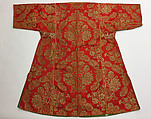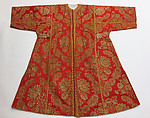Kaftan
Not on view
The Moroccan qaftane is usually fastened all the way down with a row of small buttons worked in thread. Typical of the long robes worn in other Muslim countries, it is designed to hide the body. While caftans developed as a practical response to arid conditions, providing protection against the sun, total coverage of the male form has become a well-established Muslim tradition. As Jean Besancenot explains in Costumes of Morocco (1990), "the good Muslim should be ready at any moment for prayer, which is carried out so often during the course of the day, and hence wears clothes which modestly hide the form of the body while at the same time possessing the fullness required by the prostrate positions adopted."
This image cannot be enlarged, viewed at full screen, or downloaded.
This artwork is meant to be viewed from right to left. Scroll left to view more.






